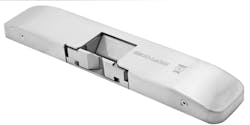As a product group, electrified locking hardware has undergone dramatic improvements since electronic access control has become an increasingly important element in security management.
In my early days, strikes were categorized for use on wood doors, metal doors and aluminum storefronts. They typically were used for retail door controls, commercial building entrances and a myriad of applications in the military and government. Some were built for security and endurance, while others were made cheaply and had short life expectancies. They all were required to be “cut” into the door jamb.
However, another category of locking devices emerged that were surface-mounted and didn’t require cutting into the jamb for installation. These include surface-mounted strikes for use with rim exit devices.
“No cut” electric strikes replace the ASA strike plate used in ANSI-prepped door jambs. The ANSI strike plate is 4-7/8-by-1-1/4 inches.
Keep in mind that where the time to attach the no-cut strike to the door jamb might be less than to cut in a conventional door strike, the strike still requires the proper control voltage be wired to it. The installer also should be forewarned that issues associated with door or jamb alignment, proper door closer operation, stack pressure, condition of the hinges, the length and angle of the latch, and the spring force extending the latch might have to be addressed to achieve proper operation.
All types of electric strikes are sensitive to back pressure (preloading), friction and misalignment, and trying to get an electric strike to operate properly can make a grown man cry.
SECO-LARM Input
We interviewed Alex Aaron, who is in technical sales with SECO-LARM, which makes no-cut and surfaced-mounted strikes.
Locksmith Ledger: With regard to no-cut and surface-mounted electric strikes, what are typical applications for these products?
Alex Aaron: Typical applications would be anything that requires electronic access control. Keys can be duplicated, but electronic access control provides more security.
LL: What must the security pro keep in mind when selecting these products?
Aaron: That every application will be different, and what works in one location may need to be changed in another.
LL: What are the biggest advantages of no-cut or surface-mounted electric strikes?
Aaron: The biggest advantage is not having to cut into a frame to fit the door strike in place and being able to automate a door.
LL: What are the drawbacks?
Aaron: The biggest drawback is the potential in a power outage that the door might be unlocked, allowing entrance, or locked, preventing exit. However, the cylindrical lockset or rim exit bar should help in these situations. The drawback covers all electronic locks, not just no-cut strikes. There really are no drawbacks for no-cut strikes.
Following are a few no-cut or surface-mounted options when you’re looking to upgrade without extra cutting.
SECO-LARM strikes
SECO-LARM makes several models of no-cut and surface-mounted electric strikes.
The SD-995C-D3Q is field-selectable for fail-safe or fail-secure operation. It can be used with virtually any cylindrical door locking system and an optional digital keypad for keyless high security. This no-cut electric strike has a reversible nonhanded design that fits either right- or left-handed doors. Its shallow design is suited for use with most metal doors and office-type applications.
The SD-998C series of surface-mounted strikes are designed for use with rim exit devices that have either a one-half inch (SD-998C-D3AQ) or three-fourths of an inch (SD-998C-D3Q) Pullman latchbolt throw. The strikes feature 12/24 VDC operating voltage, selectable fail-safe or fail-secure operation and horizontal adjustment. They can be mounted on metal or wood frames and work with standard rim-type exit devices.
More info: www.seco-larm.com
Trine 4800 Series
The Trine 4800 Series of surface-mounted strikes have built-in electronics (except for the 4850 PoE or LCD models), space plates and the company’s anchoring system. The anchoring system is aimed at ensuring secure installations by preventing the strike from shifting on the frame.
The 4800F is a 3-hour fire-rated version for use on exit devices that have a throw of three-fourths of an inch up to 1 inch. Although this model can be used fail-safe or fail-secure, as with all electric strikes, it isn’t fire-rated in fail-safe mode. This model has static strength of 3,000 pounds and can last 1.5 million cycles.
More info: www.trineonline.com
Locknetics NC Series 450
The Locknetics NC Series 450 can convert cylindrical locksets into an electronic access-controlled locking system. No cutting on the frame is required. Simply adjust the vertical-alignment feature to the latch bolt centerline and install.
This low-profile electric strike is field-selectable fail-safe or fail-secure with a simple and easy screw reversal. (Fail-secure is the default setting.) Two face plates are included: radius and square edge stainless steel.
More info: us.allegion.com
HES no-cut strikes
ASSA ABLOY brand HES has several models of no-cut or surface-mounted electric strikes.
The 8000, 8300 and 8500 series are compact, high-performance electric strikes that feature a unique concealed design. The 8000 and 8300 are for use with cylindrical locksets. The 8500 is aimed at mortise locks that don’t have a deadbolt.
No cutting on the frame is required with either series. Simply remove the existing strike plate, adjust the vertical-alignment feature to the latchbolt centerline and install. The strength of each series of strike is derived from a unique keeper pin locking design. The 8300 and 8500 are fired-rated for retrofitting into fire-rated frames.
The 8000 and 8300 accommodate latchbolts that have a throw of up to five-eighths of an inch. The 8500 accommodates latchbolts that have a throw of up to three-fourths of an inch.
More info: www.assaabloyesh.com
Tim O’Leary is an experienced security consultant and a regular contributor to Locksmith Ledger.
About the Author
Tim O'Leary
Tim O'Leary is a security consultant, trainer and technician who has also been writing articles on all areas of locksmithing & physical security for many years.
